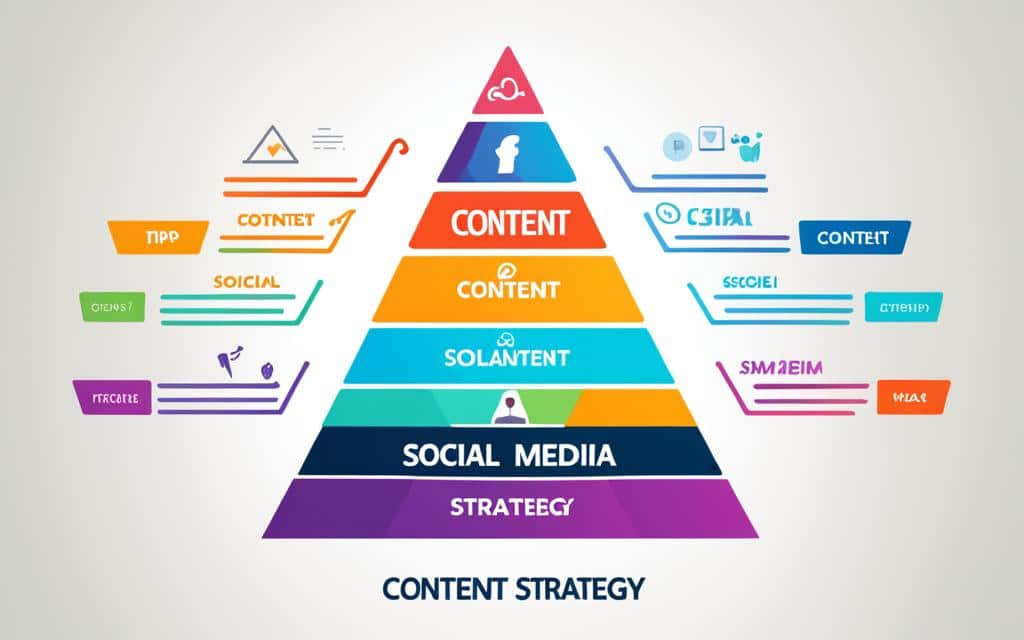Table of Contents
A social media content strategy is crucial for businesses to achieve a return on investment (ROI) from social media. It provides direction on where to post, what to post, and how often to post. Without a strategy, social media efforts may be random and scattered. Nearly 60% of the global population is on social media, making it crucial for businesses to have a solid content strategy to connect with their audience.
What Is a Social Media Content Strategy?
A social media content strategy is a documented plan that outlines how a brand will use content to grow and achieve goals on social media platforms. It includes details on what to post, when to post, and which platforms to use.
By executing a well-thought-out strategy, brands can see direct growth from social media content marketing.
A social media content strategy plays a crucial role in establishing a brand’s online presence and driving brand growth. With the right plan in place, businesses can effectively engage with their target audience, build brand recognition, and achieve their marketing objectives on social media.
A well-defined content strategy ensures that brands consistently produce valuable and relevant content that resonates with their target audience, fosters meaningful interactions, and ultimately leads to brand growth.
Building Your Social Media Content Strategy in Seven Steps
Building a social media content strategy is a crucial part of any successful digital marketing plan. By following these seven steps, businesses can develop a strategic approach to social media that maximizes engagement and drives desired outcomes.
Step 1: Set Clear Goals
Setting clear goals is the foundation of an effective social media content strategy. Aligning these goals with the brand’s overall marketing objectives ensures a cohesive approach across all channels. Whether the aim is to increase brand awareness, drive website traffic, or generate leads, establishing specific, measurable, achievable, relevant, and time-bound (SMART) objectives provides guidance for content creation and performance evaluation.
Step 2: Research the Target Audience
Understanding the target audience is essential for creating relevant and engaging content. Conducting thorough research helps identify their preferences, interests, and needs, enabling businesses to tailor their messages accordingly. By gaining insights into the demographics and psychographics of the target audience, brands can craft content that resonates and fosters a deeper connection with their followers.
Step 3: Optimize Social Media Profiles
Optimizing social media profiles enhances a brand’s online presence and ensures a professional image. This involves cohesive branding elements, such as consistent profile pictures, bios, and links to relevant websites or landing pages. By presenting a unified and visually appealing profile, businesses can establish credibility and attract more followers.
Step 4: Choose Specific Topics and Content Types
Selecting specific topic areas and content types allows brands to showcase their expertise and appeal to their target audience’s interests. By aligning content with audience preferences, businesses can deliver valuable and engaging information that keeps followers coming back for more. Understanding the preferred types of content, such as articles, videos, or infographics, enables brands to create a variety of formats that resonate with their audience.
Step 5: Create a Content Calendar
A content calendar helps brands plan and schedule their social media posts, ensuring consistent and timely delivery of content. It allows businesses to organize their content strategy and strategically align it with the best times to reach their target audience. By mapping out the content in advance, brands can maintain a steady flow of engaging posts and increase the chances of reaching and engaging with their followers.
Step 6: Engage with Others
Engaging with the audience and building relationships is a fundamental aspect of social media. By actively participating in conversations, responding to comments and messages, and initiating meaningful interactions, brands can forge connections and establish trust with their followers. This involvement creates a sense of community, encourages user-generated content, and showcases the brand’s commitment to its audience.
Step 7: Measure Results
Measuring the results of a social media content strategy is essential for evaluating its effectiveness and making informed decisions for improvement. Tracking relevant metrics, such as reach, impressions, engagement, and brand awareness, provides insights into the strategy’s performance. By analyzing these metrics regularly, brands can identify what works and what needs adjustment, enabling the refinement and optimization of future content.
Key Steps in Building a Social Media Content Strategy
| Steps | Description |
|---|---|
| 1 | Set Clear Goals |
| 2 | Research the Target Audience |
| 3 | Optimize Social Media Profiles |
| 4 | Choose Specific Topics and Content Types |
| 5 | Create a Content Calendar |
| 6 | Engage with Others |
| 7 | Measure Results |
The Importance of Setting Clear Goals
Setting clear goals is crucial for a successful social media content strategy. Goals provide focus and allow marketers to measure the effectiveness of their efforts. Common goals include increasing brand awareness, driving website traffic, generating leads, and increasing audience engagement. Clear goals should be specific, measurable, achievable, relevant, and time-bound (SMART), allowing for the evaluation of the strategy’s success.
“Setting goals is the first step in turning the invisible into the visible.” – Tony Robbins
By setting clear goals, businesses can align their social media content strategy with their overall marketing objectives. This alignment ensures that every post, tweet, or video contributes to the larger goal of growing the brand and achieving desired outcomes. Without clear goals, social media efforts can become unfocused and ineffective.
One effective approach is to set SMART goals. For example, a SMART goal for a social media content strategy could be:
- Specific: Increase brand awareness by 20% within six months.
- Measurable: Track the number of brand mentions, followers, and reach to monitor progress.
- Achievable: Set realistic targets based on current brand visibility and available resources.
- Relevant: Ensure that the goal aligns with the brand’s overall marketing objectives and target audience.
- Time-bound: Set a clear deadline for achieving the goal and establish milestones along the way.
By establishing clear goals, businesses can measure the success of their social media content strategy. Tracking key metrics such as engagement rates, conversion rates, and website traffic helps evaluate the impact of the strategy and identify areas for improvement.
| Goal | Key Metrics | Current Performance | Target |
|---|---|---|---|
| Increase brand awareness | Number of brand mentions, reach, followers | 500 brand mentions, reach of 10,000, 5,000 followers | 20% increase in brand mentions, reach of 12,000, 6,000 followers |
| Drive website traffic | Click-through rate (CTR), website visits | 2% CTR, 1,000 website visits | 5% CTR, 2,000 website visits |
| Generate leads | Number of form submissions, downloads | 100 form submissions, 50 downloads | 150 form submissions, 75 downloads |
Measurable objectives allow businesses to assess the impact of their social media content strategy and make data-driven decisions. Whether it’s increasing brand awareness, driving website traffic, or generating leads, setting clear goals ensures that efforts are directed towards achieving desired outcomes and maximizing the effectiveness of social media marketing.
Researching the Audience and Platform Selection
Effective social media content is all about personalization and engagement. To create content that resonates with your target audience, thorough audience research is crucial. By understanding their demographics, interests, and preferred platforms, you can tailor your content strategy to meet their needs.
There are various methods for conducting audience research, such as interviews, social listening, and surveys. These approaches provide valuable insights into the preferences and behaviours of your target audience, allowing you to develop content that truly connects with them.
“Audience research is the foundation of a successful social media content strategy. It helps you understand who your audience is, what they want, and where they spend their time online. Armed with this knowledge, you can create content that addresses their needs and engages them on their preferred platforms.” – Jane Smith, Digital Marketing Expert
Once you have a solid understanding of your audience, it’s time to select the most appropriate social media platforms for content distribution. Not all platforms will be the right fit for every brand, so it’s important to focus your efforts on the platforms that align with your target audience’s preferences.
A platform selection matrix can help you make informed decisions about where to invest your resources. Consider factors such as user demographics, engagement levels, content format suitability, and the platform’s alignment with your brand image and goals.
Platform Selection Matrix
| Platform | Demographics | Engagement Levels | Content Format Suitability | Brand Alignment |
|---|---|---|---|---|
| Youthful audience with a strong focus on visual content | High engagement through likes, comments, and story interactions | Well-suited for sharing photos, videos, and short-form content | Great for brand building and showcasing visually appealing products | |
| Professional audience with a focus on career development | Moderate engagement through networking and industry discussions | Best for sharing industry insights, thought leadership articles, and networking | Excellent for B2B marketing and establishing professional credibility | |
| TikTok | Youthful audience seeking entertaining and creative content | Extremely high engagement through video likes, comments, and shares | Perfect for short, engaging videos, challenges, and trends | Ideal for brands that can create authentic and entertaining content |
| A diverse audience interested in real-time news and discussions | High engagement through retweets, replies, and hashtag interactions | Best for sharing concise updates, news, and engaging in conversations | Effective for customer service, brand visibility, and thought leadership |
Remember, platform selection plays a crucial role in ensuring your content reaches the right audience and generates meaningful engagement. Utilize the insights gained from audience research to make informed decisions and personalize your content strategy accordingly.
An image depicting the importance of audience research in social media content strategy.
Optimizing Social Media Profiles
Establishing a strong online presence is crucial for businesses, and optimizing social media profiles plays a vital role in achieving this goal. By focusing on branding elements, consistency, and providing valuable information, businesses can effectively showcase their identity and influence audience perceptions.
One of the key branding elements to consider is a consistent profile picture. This visual representation helps visitors identify and remember the brand across different social media platforms. A professionally designed profile picture can leave a lasting impression and contribute to brand recognition.
A clear bio is another essential aspect of a well-optimized social media profile. The bio should concisely convey the brand’s purpose, unique selling points, and value proposition. By providing a clear and engaging description, businesses can attract the target audience’s attention and communicate their brand’s essence.
Furthermore, including appropriate links in the social media profile is vital for directing traffic to the brand’s website or other relevant online resources. These links can include the company’s website, blog, online store, or landing pages. By strategically placing links, businesses can drive website visits and conversions.
“Optimizing social media profiles is an opportunity to make a great first impression and establish credibility with your audience. Take the time to carefully consider the branding elements, consistency, and information you provide in your profiles.” – Jane Smith, Social Media Strategist
Consistency is key when it comes to social media profiles. The visual elements, tone of voice, and overall messaging should align with the brand’s identity and reflect its values. Consistency helps build brand trust, making it easier for the audience to recognize and connect with the brand across various social media platforms.
By prioritizing the optimization of social media profiles, businesses have the opportunity to shape audience perceptions, create brand loyalty, and maximize the benefits of their social media presence.
Creating a Content Calendar and Engaging with Others
As part of an effective social media content strategy, creating a content calendar is essential for maintaining a consistent publishing schedule and improving visibility. By planning posts in advance, businesses can align their content with audience preferences and maximize engagement. This proactive approach ensures that social media channels are regularly updated with fresh and relevant content, keeping followers engaged and interested.
An organized content calendar allows businesses to schedule posts at optimal times, ensuring that their content reaches the maximum number of potential customers. By strategically planning when to publish posts, businesses can increase the likelihood of reaching their target audience when they are most active on social media platforms.
Engaging with the audience and the wider community is also a critical aspect of a successful social media content strategy. By actively responding to comments, liking posts, and participating in discussions, businesses can foster a sense of connection and build brand loyalty. These interactions not only improve customer satisfaction but also help to humanize the brand and establish a positive reputation.
“Engagement with the audience is a two-way street. By showing genuine interest in what your followers have to say, you can create meaningful connections and establish yourself as a trusted authority in your industry,” says Sarah Thompson, Social Media Manager at XYZ Company.
Regularly monitoring social media metrics is key to understanding the performance of a content strategy. By tracking metrics such as reach, impressions, engagement, and brand awareness, businesses can gain valuable insights into the effectiveness of their content. These metrics provide data-driven evidence to guide future content decisions and identify areas that may require adjustments or optimizations.
Content Calendar Example:
| Date | Post | Platform |
|---|---|---|
| 1st March | Showcase your brand’s latest product and its features | |
| 5th March | Share a customer success story and invite testimonials | |
| 10th March | Post a behind-the-scenes video showcasing your team and work culture | |
| 15th March | Ask a thought-provoking question related to your industry |
Having a well-planned content calendar not only helps businesses stay organized but also ensures that their social media efforts are focused and strategic. By consistently delivering valuable and engaging content, businesses can build a dedicated following and drive meaningful interactions that contribute to brand growth and success.
Measuring the Effectiveness of Your Content
Measuring the effectiveness of a social media content strategy is crucial for tracking progress and identifying areas for improvement. By analyzing relevant social media metrics and conducting data analysis, marketers can gain valuable insights into the performance of their content and make data-driven decisions for optimization.
Here are some key social media metrics that provide insights into the performance of your content strategy:
- Reach: The number of unique users who have seen your content.
- Impressions: The total number of times your content has been displayed.
- Engagement: The level of interaction and involvement your content generates, such as likes, comments, and shares.
- Follower Growth: The rate at which your social media followers increase over time.
- Brand Awareness: The extent to which your brand is recognized and recalled by your target audience.
- Click-Through Rate (CTR): The percentage of users who click on a link within your content.
- Brand Sentiment: The overall perception and sentiment towards your brand on social media.
By regularly analyzing these metrics, you can gain a deeper understanding of what content resonates with your audience and what strategies are most effective. This allows you to make informed adjustments to your content strategy to drive better results and achieve your marketing goals.
Example of Social Media Metrics Analysis
Let’s consider a hypothetical scenario where a beauty brand wants to measure the effectiveness of their content strategy on Instagram. They analyze the following metrics for a specific time period:
| Metric | Value |
|---|---|
| Reach | 100,000 |
| Impressions | 500,000 |
| Engagement | 10,000 |
| Follower Growth | 2% |
| Brand Awareness | 75% |
| Click-Through Rate (CTR) | 3% |
| Brand Sentiment | Positive |
Based on the analysis, the beauty brand can conclude that their content is reaching a significant number of users, generating high impressions, and driving engagement. The 2% follower growth indicates a positive trend in audience acquisition. The brand’s high brand awareness percentage demonstrates good recognition among their target audience. With a CTR of 3%, the brand’s content is effectively engaging users and driving them to take action. Finally, the positive brand sentiment indicates a favorable perception of the brand on social media.
By analyzing these metrics, the beauty brand can refine their content strategy by focusing on the types of content that generate the highest engagement and optimizing their approach to further drive growth and brand awareness.
Conclusion
A well-executed social media content strategy is crucial for businesses to achieve consistent engagement and drive growth. By setting clear goals, researching the audience, optimizing profiles, creating a content calendar, engaging with the community, and measuring performance, businesses can develop an effective plan for their social media content.
Consistency is key in maintaining a strong online presence. By consistently delivering valuable and relevant content, businesses can build trust and credibility with their audience, ultimately leading to increased engagement and brand loyalty.
Effective planning is crucial for social media success. Taking the time to strategically plan and schedule content allows businesses to align their messages with audience preferences and optimize engagement. Regularly measuring the performance of the content strategy provides valuable insights and enables businesses to make data-driven decisions to enhance their social media efforts.
In conclusion, a well-crafted social media content strategy, combined with consistent engagement and effective planning, can significantly impact a business’s online presence, attract a loyal following, and drive growth in the digital landscape.
FAQ
What is a social media content strategy?
A social media content strategy is a documented plan that outlines how a brand will use content to grow and achieve goals on social media platforms. It includes details on what to post, when to post, and which platforms to use.
Why is setting clear goals important for a social media content strategy?
Setting clear goals is crucial for a successful social media content strategy. Goals provide focus and allow marketers to measure the effectiveness of their efforts.
How can I research my target audience and select the right social media platforms?
Researching the target audience is essential for creating personalized and engaging content. Marketers can gather insights through methods such as interviews, social listening, and surveys. Understanding the audience’s demographics, interests, and preferred platforms helps in selecting the most effective social media platforms for content distribution.
How can I optimize my social media profiles?
Optimizing social media profiles is crucial for establishing a strong online presence. Branding elements like a consistent profile picture, clear bio, and appropriate links should be included to help visitors understand the brand and its offerings.
Why is creating a content calendar important?
Creating a content calendar helps maintain a consistent publishing schedule and improves visibility. Planning posts in advance allows businesses to align their content with audience preferences and maximize engagement.
How can I engage with my audience and build relationships through social media?
Engaging with the audience and the wider community through likes, comments, and replies fosters a sense of connection and builds brand loyalty.
How can I measure the effectiveness of my social media content strategy?
Measuring the effectiveness of a social media content strategy is essential for tracking progress and identifying areas for improvement. Metrics such as reach, impressions, engagement, follower growth, brand awareness, click-through rate (CTR), and brand sentiment provide insights into the performance of the content.
What are the key elements for a successful social media content strategy?
Consistency, relevance, and an audience-centric approach are key elements that contribute to the success of a social media content strategy.













